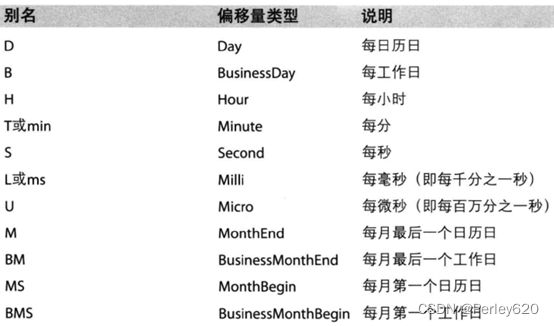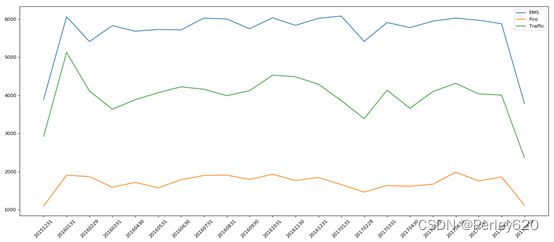python学习——pandas数据处理 & 时间序列案例 & matplotlib绘图案例
目录
- pandas数据处理
- 1.合并数据
-
- 1) 堆叠合并
- 2) 主键合并
- 3) 重叠合并
- 2.分组和聚合
- 3.索引和符合索引
- 4.去除重复值
- 5.处理缺失值
- 6.处理离群值
- 7.标准化数据
-
- 1) 离差标准化函数
- 2) 标准差标准化函数
- 3) 小数定标差标准化函数
- 8.转换数据--离散处理
- 9.时间序列
- 【案例】时间序列案例
-
- 案例1:911的紧急电话的数据
-
- 1)请统计出出这些数据中不同类型的紧急情况的次数
- 2)不同月份不同类型 、不同月份电话次数
- 案例2:空气质量数据
- 案例3:简单的预测问题
- 【案例】matplotlib绘图案例
-
- 案例一:店铺总数排名前10的国家+中国每个城市的店铺数量
- 案例二:全球排名靠前的10000本书的数据
pandas数据处理
1.合并数据
merge:按照指定的列把数据按照一定的方式合并到一起
默认的合并方式inner,交集
merge outer,并集,NaN补全
merge left,左边为准,NaN补全
merge right,右边为准,NaN补全
1) 堆叠合并
#内连inner返回索引重叠部分,外连outer返回返回并集数据
#1行对齐,0列对齐
pd.concat([df1,df2],axis=1,join='inner')
pd.concat([df1,df2],axis=1,join='outer')
pd.concat([df3,df4],axis=0,join='inner')
df3.append(df4) #纵向堆叠,列名必须一致
2) 主键合并
pd.merge(detail1,order,left_on='order_id',right_on = 'info_id')
data1=pd.merge(prior,products,on=["product_id","product_id"])
order.rename({'info_id':'order_id'},inplace=True) #换名字
detail1.join(order,on='order_id',rsuffix='1') #主键名必须一样
3) 重叠合并
dict2 = {'ID':[1,2,3,4,5,6,7,8,9],
'System':[np.nan,np.nan,'win7',np.nan,
'win8','win7',np.nan,np.nan,np.nan],
'cpu':[np.nan,np.nan,'i3',np.nan,'i7',
'i5',np.nan,np.nan,np.nan]}
## 转换两个字典为DataFrame
df5 = pd.DataFrame(dict1)
df6 = pd.DataFrame(dict2)
df5.combine_first(df6) #两表数据一一比较,完整表格内容
2.分组和聚合
grouped = df.groupby(by=“columns_name”)
grouped是一个DataFrameGroupBy对象,是可迭代的
grouped中的每一个元素是一个元组
元组里面是(索引(分组的值),分组之后的DataFrame)
import pandas as pd
import numpy as np
file_path = "./starbucks_store_worldwide.csv"
df = pd.read_csv(file_path)
print(df.head(1))
print(df.info())
grouped = df.groupby(by="Country")
# print(grouped)
#DataFrameGroupBy
#可以进行遍历
for i,j in grouped:
print(i)
print("-"*100)
print(j,type(j))
print("*"*100)
df[df["Country"]=="US"]
#调用聚合方法,统计求和
country_count = grouped["Brand"].count()
print(country_count["US"])
print(country_count["CN"])
#统计中国每个省店铺的数量
china_data = df[df["Country"] =="CN"]
grouped = china_data.groupby(by="State/Province").count()["Brand"]
print(grouped)
#数据按照多个条件进行分组,返回Series
grouped = df["Brand"].groupby(by=[df["Country"],df["State/Province"]]).count()
print(grouped)
print(type(grouped))
#数据按照多个条件进行分组,返回DataFrame
grouped1 = df[["Brand"]].groupby(by=[df["Country"],df["State/Province"]]).count()
# grouped2= df.groupby(by=[df["Country"],df["State/Province"]])[["Brand"]].count()
# grouped3 = df.groupby(by=[df["Country"],df["State/Province"]]).count()[["Brand"]]
print(grouped1,type(grouped1))
# print("*"*100)
# print(grouped2,type(grouped2))
# print("*"*100)
# print(grouped3,type(grouped3))
#索引的方法和属性
print(grouped1.index)
3.索引和符合索引
简单的索引操作:
• 获取index:df.index
• 指定index :df.index = [‘x’,‘y’]
• 重新设置index : df.reindex(list(“abcedf”))
• 指定某一列作为index :df.set_index(“Country”,drop=False)
• 返回index的唯一值:df.set_index(“Country”).index.unique()
• a.set_index([“c”,“d”])即设置两个索引
Series复合索引
4.去除重复值
detail['dishes_name'].drop_duplicates()#去重全部列
detail.drop_duplicates(subset = ['order_id','emp_id']) #去重某些列
5.处理缺失值
对于NaN的数据,在numpy中我们是如何处理的?
在pandas中我们处理起来非常容易
判断数据是否为NaN:pd.isnull(df),pd.notnull(df)
处理方式1:删除NaN所在的行列t.dropna (axis=0, how=‘any’, inplace=False)
处理方式2:填充数据,t.fillna(t.mean()),t.fiallna(t.median()),t.fillna(0)
![]()
处理为0的数据:t[t==0]=np.nan
当然并不是每次为0的数据都需要处理
计算平均值等情况,nan是不参与计算的,但是0会
detail.isnull().sum() #特征缺失的数目
detail.notnull().sum() #特征非缺失的数目
detail.dropna(axis = 1,how ='any') #去除缺失的列
detail = detail.fillna(-99) #替换缺失值
from scipy.interpolate import interp1d
LinearInsValue1 = interp1d(x,y1,kind='linear') ##线性插值拟合x,y1
print('当x为6、7时,使用线性插值y1为:',LinearInsValue1([6,7]))
LargeInsValue1 = lagrange(x,y1) ##拉格朗日插值拟合x,y1
SplineInsValue1 = spline(x,y1,xnew=np.array([6,7]))
6.处理离群值
import matplotlib.pyplot as plt
plt.figure(figsize=(10,8))
p = plt.boxplot(detail['counts'].values,notch=True) ##画出箱线图
outlier1 = p['fliers'][0].get_ydata() ##fliers为异常值的标签
plt.savefig('../tmp/菜品异常数据识别.png')
plt.show()
## 定义拉依达准则识别异常值函数
def outRange(Ser1):
boolInd = (Ser1.mean()-3*Ser1.std()>Ser1) | \
(Ser1.mean()+3*Ser1.var()< Ser1)
index = np.arange(Ser1.shape[0])[boolInd]
outrange = Ser1.iloc[index]
return outrange
outlier = outRange(detail['counts'])
print('使用3o原则拉依达准则判定异常值个数为:',outlier.shape[0])
print('异常值的最大值为:',outlier.max())
print('异常值的最小值为:',outlier.min())
7.标准化数据
1) 离差标准化函数
## 自定义离差标准化函数
def MinMaxScale(data):
data=(data-data.min())/(data.max()-data.min())
return data
##对菜品订单表售价和销量做离差标准化
data1=MinMaxScale(detail['counts'])
2) 标准差标准化函数
##自定义标准差标准化函数
def StandardScaler(data):
data=(data-data.mean())/data.std()
return data
##对菜品订单表售价和销量做标准化
data4=StandardScaler(detail['counts'])
3) 小数定标差标准化函数
##自定义小数定标差标准化函数
def DecimalScaler(data):
data=data/10**np.ceil(np.log10(data.abs().max()))
return data
##对菜品订单表售价和销量做标准化
data7=DecimalScaler(detail['counts'])
8.转换数据–离散处理
##哑变处理(非数值型数据处理)
pd.get_dummies(data)
##等宽法离散
price = pd.cut(detail['amounts'],5)
##自定义等频法离散化函数
def SameRateCut(data,k):
w=data.quantile(np.arange(0,1+1.0/k,1.0/k))
data=pd.cut(data,w)
return data
result=SameRateCut(detail['amounts'],5).value_counts() #售价等频法离散化
#自定义数据k-Means聚类离散化函数
def KmeanCut(data,k):
from sklearn.cluster import KMeans #引入KMeans
kmodel=KMeans(n_clusters=k) #建立模型
kmodel.fit(data.values.reshape((len(data), 1))) #训练模型
c=pd.DataFrame(kmodel.cluster_centers_).sort_values(0) #输出聚类中心并排序
w=c.rolling(2).mean().iloc[1:] #相邻两项求中点,作为边界点
w=[0]+list(w[0])+[data.max()] #把首末边界点加上
data=pd.cut(data,w)
return data
#菜品售价等频法离散化
result=KmeanCut(detail['amounts'],5).value_counts()
9.时间序列
Lat,lng:经纬度
pd.date_range(start=None, end=None, periods=None, freq=‘10D’)#十天
start和end以及freq配合能够生成start和end范围内以频率freq的一组时间索引
start和periods以及freq配合能够生成从start开始的频率为freq的periods个时间索引
index=pd.date_range(“20170101”,periods=10)
df = pd.DataFrame(np.random.rand(10),index=index)
回到最开始的911数据的案例中,我们可以使用pandas提供的方法把时间字符串转化为时间序列
df[“timeStamp”] = pd.to_datetime(df[“timeStamp”],format=“”)
format参数大部分情况下可以不用写,但是对于pandas无法格式化的时间字符串,我们可以使用该参数,比如包含中文
重采样
重采样:指的是将时间序列从一个频率转化为另一个频率进行处理的过程,将高频率数据转化为低频率数据为降采样,低频率转化为高频率为升采样
pandas提供了一个resample的方法来帮助我们实现频率转化
t=pd.DataFrame(np.random.uniform(10,50,(100,1)),index=pd.date_range("20170101",periods=100))
a=t.resample("10D").mean()
b=t.resample("QS-JAN").count()#每季度最后一月第一个日历日
print(b)
DatetimeIndex可以理解为时间戳
PeriodIndex可以理解为时间段
periods = pd.PeriodIndex(year=data["year"],month=data["month"],day=data["day"],hour=data["hour"],freq="H")
那么如果给这个时间段降采样呢?
data = df.set_index(periods).resample("10D").mean()
【案例】时间序列案例
显示中文,输出大列表处理
plt.rcParams['font.sans-serif'] = 'SimHei'
plt.rcParams['axes.unicode_minus'] = False ## 设置正常显示符号
# 设置显示的最大列、宽等参数,消掉打印不完全中间的省略号
# pd.set_option('display.max_columns', 1000)
pd.set_option('display.width', 1000)#加了这一行那表格的一行就不会分段出现了
# pd.set_option('display.max_colwidth', 1000)
# pd.set_option('display.height', 1000)
#显示所有列
pd.set_option('display.max_columns', None)
#显示所有行
pd.set_option('display.max_rows', None)
案例1:911的紧急电话的数据
现在我们有2015到2017年25万条911的紧急电话的数据,请统计出出这些数据中不同类型的紧急情况的次数,如果我们还想统计出不同月份不同类型紧急电话的次数的变化情况,应该怎么做呢?
1)请统计出出这些数据中不同类型的紧急情况的次数
我的方法:用时太长
import pandas as pd
import matplotlib.pyplot as plt
import numpy as np
file_path = "./911.csv"
df = pd.read_csv(file_path)
# print(df.info())
# print(df.head(10))
#字符串转换成列表,取第一个字符串
a=df["title"].str.split(":").tolist()
type_list=[i[0] for i in a]
# print(type_list)
temp_list = type_list
genre_list = list(set(type_list))
#构造全为0的数组
zeros_df = pd.DataFrame(np.zeros((df.shape[0],len(genre_list))),columns=genre_list)
#给每个电影出现分类的位置赋值1
for i in range(df.shape[0]):
#zeros_df.loc[0,["Sci-fi","Mucical"]] = 1
zeros_df.loc[i,temp_list[i]] = 1
#统计每个分类的电影的数量和
genre_count = zeros_df.sum(axis=0)
print(genre_count)
#排序
genre_count = genre_count.sort_values()
_x = genre_count.index
_y = genre_count.values
#画图
plt.figure(figsize=(20,8),dpi=80)
plt.bar(range(len(_x)),_y,width=0.4,color="orange")
plt.xticks(range(len(_x)),_x)
plt.show()
方法2:遍历次数减少,布尔索引赋值
# coding=utf-8
import pandas as pd
import numpy as np
from matplotlib import pyplot as plt
df = pd.read_csv("./911.csv")
print(df.head(5))
#获取分类
# print()df["title"].str.split(": ")
temp_list = df["title"].str.split(": ").tolist()
cate_list = list(set([i[0] for i in temp_list]))
print(cate_list)
#构造全为0的数组
zeros_df = pd.DataFrame(np.zeros((df.shape[0],len(cate_list))),columns=cate_list)
#赋值
for cate in cate_list:
zeros_df[cate][df["title"].str.contains(cate)] = 1
# break
# print(zeros_df)
sum_ret = zeros_df.sum(axis=0)
print(sum_ret)
方法3:添加一列,按照该列进行分组
# coding=utf-8
import pandas as pd
import numpy as np
from matplotlib import pyplot as plt
df = pd.read_csv("./911.csv")
print(df.head(5))
#获取分类
# print()df["title"].str.split(": ")
temp_list = df["title"].str.split(": ").tolist()
cate_list = [i[0] for i in temp_list]
df["cate"] = pd.DataFrame(np.array(cate_list).reshape((df.shape[0],1)))
# print(df.head(5))
print(df.groupby(by="cate").count()["title"])
2)不同月份不同类型 、不同月份电话次数
第二问
- 统计出911数据中不同月份电话次数的变化情况
- 统计出911数据中不同月份不同类型的电话的次数的变化情况
重新定义时间格式,时间那一列更改
import pandas as pd
import numpy as np
from matplotlib import pyplot as plt
df = pd.read_csv("./911.csv")
df["timeStamp"] = pd.to_datetime(df["timeStamp"])
df.set_index("timeStamp",inplace=True)#原地替换
#统计出911数据中不同月份电话次数的
count_by_month = df.resample("M").count()["title"]
print(count_by_month)
#画图
_x = count_by_month.index
_y = count_by_month.values
# for i in _x:
# print(dir(i))
# break
_x = [i.strftime("%Y%m%d") for i in _x] #重新定义时间的格式
plt.figure(figsize=(20,8),dpi=80)
plt.plot(range(len(_x)),_y)
plt.xticks(range(len(_x)),_x,rotation=45)
plt.show()
第二问我的
import pandas as pd
import matplotlib.pyplot as plt
import numpy as np
file_path = "./911.csv"
df = pd.read_csv(file_path)
# print(df.info())
df["timeStamp"] = pd.to_datetime(df["timeStamp"],format="")
temp_list = df["title"].str.split(": ").tolist()
cate_list = [i[0] for i in temp_list]
df["cate"] = pd.DataFrame(np.array(cate_list).reshape((df.shape[0],1)))
# print(df.info())
data_mon=df.set_index("timeStamp")
grouped=data_mon.groupby(by="cate")
plt.figure(figsize=(20,8),dpi=80)
for i,j in grouped:
data1=j.resample("M").count()["title"]
_x = data1.index
_y = data1.values
plt.plot(range(len(_x)),_y,label="i")
_x = [i.strftime("%Y%m%d") for i in _x] #重新定义时间的格式
plt.xticks(range(len(_x)),_x,rotation=45)
plt.show()
第二问 分组后的遍历画图Group
# coding=utf-8
#911数据中不同月份不同类型的电话的次数的变化情况
import pandas as pd
import numpy as np
from matplotlib import pyplot as plt
#把时间字符串转为时间类型设置为索引
df = pd.read_csv("./911.csv")
df["timeStamp"] = pd.to_datetime(df["timeStamp"])
#添加列,表示分类
temp_list = df["title"].str.split(": ").tolist()
cate_list = [i[0] for i in temp_list]
# print(np.array(cate_list).reshape((df.shape[0],1)))
df["cate"] = pd.DataFrame(np.array(cate_list).reshape((df.shape[0],1)))
df.set_index("timeStamp",inplace=True)
print(df.head(1))
plt.figure(figsize=(20, 8), dpi=80)
#分组
for group_name,group_data in df.groupby(by="cate"):
#对不同的分类都进行绘图
count_by_month = group_data.resample("M").count()["title"]
# 画图
_x = count_by_month.index
print(_x)
_y = count_by_month.values
_x = [i.strftime("%Y%m%d") for i in _x]
plt.plot(range(len(_x)), _y, label=group_name)
plt.xticks(range(len(_x)), _x, rotation=45)
plt.legend(loc="best")
plt.show()
案例2:空气质量数据
现在我们有北上广、深圳、和沈阳5个城市空气质量数据,请绘制出5个城市的PM2.5随时间的变化情况
观察这组数据中的时间结构,并不是字符串,这个时候我们应该怎么办?
数据来源: https://www.kaggle.com/uciml/pm25-data-for-five-chinese-cities
请绘制出5个城市的PM2.5随时间的变化情况
分开的时间数据处理,时间格式重新定义
# coding=utf-8
import pandas as pd
from matplotlib import pyplot as plt
file_path = "./PM2.5/BeijingPM20100101_20151231.csv"
df = pd.read_csv(file_path)
#把分开的时间字符串通过periodIndex的方法转化为pandas的时间类型
period = pd.PeriodIndex(year=df["year"],month=df["month"],day=df["day"],hour=df["hour"],freq="H")
df["datetime"] = period
# print(df.head(10))
#把datetime 设置为索引
df.set_index("datetime",inplace=True)
#进行降采样
df = df.resample("7D").mean()
print(df.head())
#处理缺失数据,删除缺失数据
# print(df["PM_US Post"])
data =df["PM_US Post"]
data_china = df["PM_Nongzhanguan"]
print(data_china.head(100))
#画图
_x = data.index
_x = [i.strftime("%Y%m%d") for i in _x]
_x_china = [i.strftime("%Y%m%d") for i in data_china.index]
print(len(_x_china),len(_x_china))
_y = data.values
_y_china = data_china.values
plt.figure(figsize=(20,8),dpi=80)
plt.plot(range(len(_x)),_y,label="US_POST",alpha=0.7)
plt.plot(range(len(_x_china)),_y_china,label="CN_POST",alpha=0.7)
plt.xticks(range(0,len(_x_china),10),list(_x_china)[::10],rotation=45)
plt.legend(loc="best")
plt.show()
案例3:简单的预测问题

缩小数据,选取部分数据;删除数据,分组后逆向操作;isin操作
# 读取数据
data = pd.read_csv("./data/FBlocation/train.csv")
# print(data.head(10))
# 处理数据
# 1、缩小数据,查询数据晒讯
data = data.query("x > 1.0 & x < 1.25 & y > 2.5 & y < 2.75")
# 处理时间的数据
time_value = pd.to_datetime(data['time'], unit='s')
print(time_value)
# 把日期格式转换成 字典格式
time_value = pd.DatetimeIndex(time_value)
# 构造一些特征
data['day'] = time_value.day
data['hour'] = time_value.hour
data['weekday'] = time_value.weekday
# 把时间戳特征删除
data = data.drop(['time'], axis=1)#1表示列,0表示行
print(data)#没有时间戳特征的数据
# 把签到数量少于n个目标位置删除
place_count = data.groupby('place_id').count()
tf = place_count[place_count.row_id > 3].reset_index()#分组后逆操作,重新设置索引
data = data[data['place_id'].isin(tf.place_id)]
# 取出数据当中的特征值和目标值
y = data['place_id']#取目标值
x = data.drop(['place_id'], axis=1)#删除特征值就得到目标值
【案例】matplotlib绘图案例
案例一:店铺总数排名前10的国家+中国每个城市的店铺数量
使用matplotlib呈现出店铺总数排名前10的国家
使用matplotlib呈现出中国每个城市的店铺数量
import pandas as pd
import matplotlib.pyplot as plt
file_path = "./starbucks_store_worldwide.csv"
df = pd.read_csv(file_path)
df1 = df[["Brand"]].groupby(by=[df["Country"]]).count()
genre_count1 = df1.sort_values(by="Brand",ascending=False)[:10]
_x = genre_count1.index
_y = genre_count1.iloc[:,0]
#画图
plt.figure(figsize=(20,8),dpi=80)
plt.bar(range(len(_x)),_y,width=0.4,color="orange")
plt.xticks(range(len(_x)),_x)
plt.show()
import pandas as pd
from matplotlib import pyplot as plt
file_path = "./starbucks_store_worldwide.csv"
df = pd.read_csv(file_path)
#使用matplotlib呈现出店铺总数排名前10的国家
#准备数据
data1 = df.groupby(by="Country").count()["Brand"].sort_values(ascending=False)[:10]
_x = data1.index
_y = data1.values
#画图
plt.figure(figsize=(20,8),dpi=80)
plt.bar(range(len(_x)),_y)
plt.xticks(range(len(_x)),_x)
plt.show()
import pandas as pd
import matplotlib.pyplot as plt
plt.rcParams['font.sans-serif'] = 'SimHei'
plt.rcParams['axes.unicode_minus'] = False ## 设置正常显示符号
pd.set_option('display.width', 1000)#加了这一行那表格的一行就不会分段出现了
pd.set_option('display.max_columns', None)
pd.set_option('display.max_rows', None)
file_path = "./starbucks_store_worldwide.csv"
df = pd.read_csv(file_path)
china_data = df[df["Country"] =="CN"]
grouped = china_data.groupby(by="City").count()["Brand"].sort_values(ascending=False)
print(grouped)
data1=grouped[:25]
_x = data1.index
_y = data1.values
#画图
plt.figure(figsize=(20,8),dpi=80)
plt.bar(range(len(_x)),_y,width=0.3)
plt.xticks(range(len(_x)),_x,rotation=45)
plt.show()
案例二:全球排名靠前的10000本书的数据
现在我们有全球排名靠前的10000本书的数据,那么请统计一下下面几个问题:
- 不同年份书的数量
- 不同年份书的平均评分情况
import pandas as pd
import matplotlib.pyplot as plt
plt.rcParams['font.sans-serif'] = 'SimHei'
plt.rcParams['axes.unicode_minus'] = False ## 设置正常显示符号
pd.set_option('display.width', 1000)#加了这一行那表格的一行就不会分段出现了
pd.set_option('display.max_columns', None)
pd.set_option('display.max_rows', None)
file_path = "books.csv"
df = pd.read_csv(file_path)
# print(df.info())
# print(df.head(1))
df1=df[pd.notnull(df["original_publication_year"])]#处理缺失值
book_year_num=df1.groupby(by="original_publication_year").count()["id"].sort_values(ascending=False)
#第二问:不同年份的书的平均评分
book_mean_rates=df1["average_rating"].groupby(by=df1["original_publication_year"]).mean()
#画图
plt.figure(figsize=(20,10),dpi=80)
_x=book_mean_rates.index
_y=book_mean_rates.values
plt.plot(range(len(_x)),_y)
plt.xticks(list(range(len(_x)))[::10],_x[::10].astype(int))#rotation旋转90度
plt.show()











